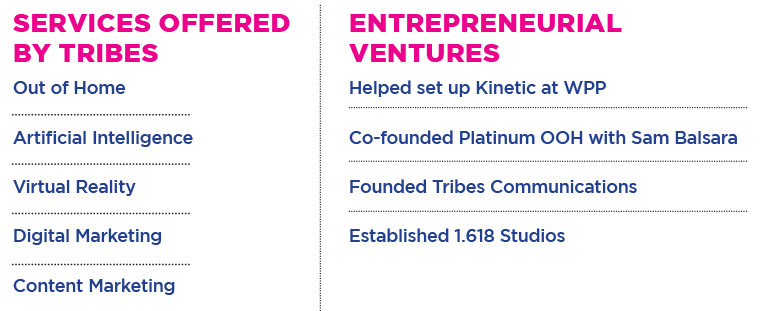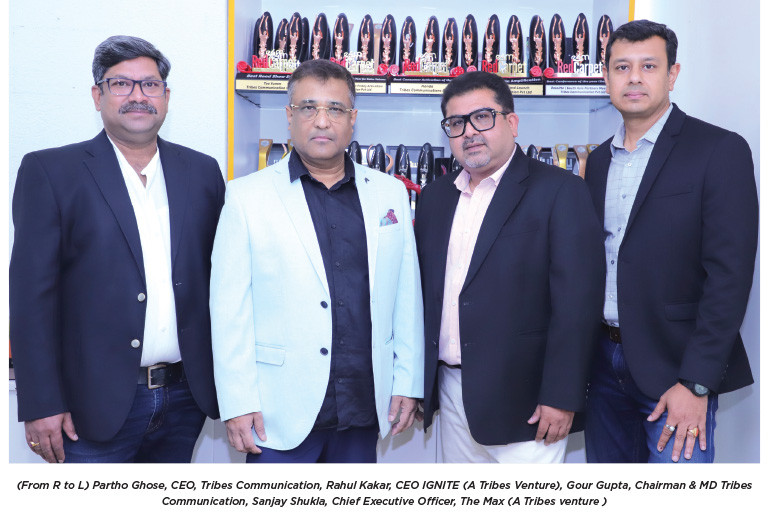In under a decade, Tribes Communication has evolved from an out-of-home (OOH) advertising firm into a full-spectrum marketing agency, offering services in brand activations, events, retail, rural marketing, sports marketing, digital marketing, content creation, and talent management. With a remarkable revenue of INR 800cr., Tribes is gearing up for an IPO by 2027, marking its impressive journey in the industry.
Gour Gupta, an industry stalwart and the Chairman and Managing Director of Tribes Communication, sheds light on the significant evolution of the OOH sector. Traditional OOH advertising—characterised by billboards, posters, and transit ads—is being revolutionised by advancements in technology, data analytics, and changing consumer behaviours. These changes are making public advertising more dynamic, targeted, and interactive.
According to Gupta, the most profound shift in OOH advertising is the integration of digital technology. Digital Out-of-Home (DOOH) advertising has ushered in a new era of flexibility and engagement. Digital billboards and screens, now common in urban landscapes, offer high-resolution displays capable of showcasing multiple ads in a loop. Unlike static billboards, which require physical updates, digital screens can be updated remotely in real time, allowing for timely and relevant messaging.
The transformation in OOH advertising is also aligned with growing sustainability initiatives and smart city projects. Digital displays are more energy-efficient and can be powered by renewable energy sources, reducing their environmental impact. Furthermore, smart city infrastructure—such as connected streetlights and public Wi-Fi—provides new platforms for digital advertising, simultaneously enhancing urban living.
Looking ahead, the future of OOH advertising appears increasingly promising as technology continues to advance. The integration of artificial intelligence (AI) and machine learning will further enhance the ability to deliver personalised and contextually relevant ads. Advanced facial recognition technology could enable ads to change based on the viewer’s age, gender, or even mood, pushing the boundaries of targeted marketing.
With a bold vision for the future, Gupta is aggressively targeting INR 1000cr. in capitalized billing by March 2025. As OOH continues to experience significant growth, Tribes Communication stands at the forefront, leading the industry’s transformation.
Tribes Communication’s journey from a traditional OOH company to a comprehensive marketing agency underscores its innovative approach and strategic foresight. The company’s ability to adapt to technological advancements and shifting market dynamics has positioned it as a leader in the advertising industry, ready to capitalise on the opportunities of the future.
‘Brands need to think beyond the traditional billboard approach’

Gour Gupta, Chairman & MD of Tribes Communication in an in-depth conversation with Ruhail Amin talks about how Tribes has used technology, big data and analytics to its advantage, allowing for better measurement of OOH campaigns and what lies ahead for the medium
Q] How do you see out-of-home advertising evolve in the coming years?
Out-of-Home (OOH) advertising has always been a dynamic and impactful medium for reaching audiences outside their homes. In recent years, the OOH industry has witnessed significant transformations, driven by advancements in technology, changing consumer behaviours, and the need for innovative and engaging advertising solutions. The advent of Digital technology has revolutionised the OOH industry. Digital displays, including LED billboards, digital signage, and interactive screens have transformed static advertising spaces into dynamic and engaging platforms.
Data-driven targeting is becoming increasingly essential in OOH advertising. With the integration of advanced analytics, audience measurement tools, and location data, advertisers can deliver highly targeted and personalised messages. The integration of OOH advertising with mobile and digital channels has become a powerful trend. By leveraging mobile technology, QR codes, or Bluetooth beacons, OOH ads can interact with smartphones, allowing for seamless integration between offline and online experiences. Personalisation and contextual relevance are driving the future of OOH advertising. Advertisers are leveraging data insights and dynamic content delivery to create tailored messages based on factors like location, time, weather, or audience demographics.
To stand out in a crowded advertising landscape, OOH campaigns are focusing on delivering creative and interactive experiences. Immersive technologies like augmented reality (AR) and virtual reality (VR) are being integrated into OOH ads to provide captivating and memorable experiences for audiences. Sustainability has emerged as a significant trend in the OOH industry. Advertisers are seeking environment-friendly solutions, such as LED lighting, energy-efficient displays, and solar-powered installations, to reduce the ecological impact of OOH campaigns.
Q] Are there any emerging markets or untapped opportunities that hold significant potential for OOH and Digital advertising?
To truly unlock the full potential of this medium, brands need to think beyond the traditional billboard approach. By getting creative with their OOH strategy, such as utilising digital screens, experiential installations, or interactive displays, brands can better engage with their target audience and create a memorable impact. So, if a brand wants to stand out and make the most of its OOH advertising dollars, it’s essential to think outside the billboard box. Creative OOH campaigns set themselves apart by disrupting the mundane. Clever copy, eye-catching visuals, interactive elements, and unexpected placements give viewers an experience they won’t expect and won’t soon forget.
Take Apple’s ‘Shot on iPhone’ campaign that began in 2015 and has since become a global sensation. It features stunning user-generated photos and videos captured on iPhones. This campaign has been effective because it showcases the exceptional camera capabilities of iPhones while celebrating the creativity of its users.

Q] How do you see artificial intelligence influencing the future of advertising in the realm of personalised and immersive brand experiences?
As we stand on the brink of a new era, the integration of Artificial Intelligence (AI) is reshaping video advertising, transcending traditional boundaries and ushering in a wave of immersive brand experiences. AI algorithms are making this a reality by analysing user data to create highly personalised video content. It is transforming video advertising from a one-size-fits-all approach to a personalized, immersive experience.
Through advanced data analysis, AI identifies patterns in user behaviour, allowing for precise targeting. This maximizes engagement by delivering content that aligns with the viewer’s interests, behaviours, and demographics. AI-driven shoppable videos seamlessly integrate e-commerce, allowing consumers to make purchases directly from the video, transforming the viewing experience into a transactional journey.
AI enables dynamic video optimization in real-time, adjusting elements such as pacing, colour schemes, and even narrative flow based on user reactions and engagement levels.
AI is bringing emotional intelligence to video advertising by analysing facial expressions, tone of voice, and even user comments. The future holds the promise of AI-driven storytelling that adapts in real-time to evoke specific emotions and enhance brand affinity.

Q] How does Tribes use data and analytics to understand audience behaviour and preferences?
Often, OOH is considered to be mass media with limited or no measurability. Tribes has used technology, big data and analytics to its advantage and helped research, plan and measure outdoor campaigns better. Most of our campaigns are planned with Target Group Index (TGI) data to understand audience behaviour, consumption patterns and habits, most visited hotspots, etc.
Our planners further layer this data into our in-house campaign planning and audience measurement tool. Basis the given inputs, it generates a heat map of the locations in a city where there are higher TG congregation points. The sites are then evaluated based on the measurability index of sites, i.e., 8 key parameters such as size, angle, eccentricity, height, illumination, clutter, obstructions and visible distance. Further, AdEx data coupled with industry reports are used to build a comprehensive OOH media plan. Pre and post-evaluation reports of the plan are generated thus providing campaign effectiveness & ROI measurement.

Q] What metrics do you consider most important when tracking the success of an OOH or digital campaign?
By focusing on a combination of impressions, reach, frequency, engagement, location-based metrics, conversion rates & brand awareness, marketers can gain a comprehensive understanding of their campaign’s impact and make informed decisions for future initiatives. Also, as technology continues to evolve, so will the methods of measuring OOH campaign success. This will enable businesses to refine their strategies and deliver even more compelling campaigns in the future.
Q] With increasing focus on sustainability, how is Tribes incorporating eco-friendly practices into its operations and campaigns?
Education, awareness and implementation are all critical aspects of sustainability. Both Tribes as well as our clients have started the journey. We are encouraging our clients to talk about their sustainability initiatives to spread awareness. The McDonalds campaign is a good example. In terms of operations, we have started with the recycling and re-usage of vinyl flex which is used in outdoor hoardings.























